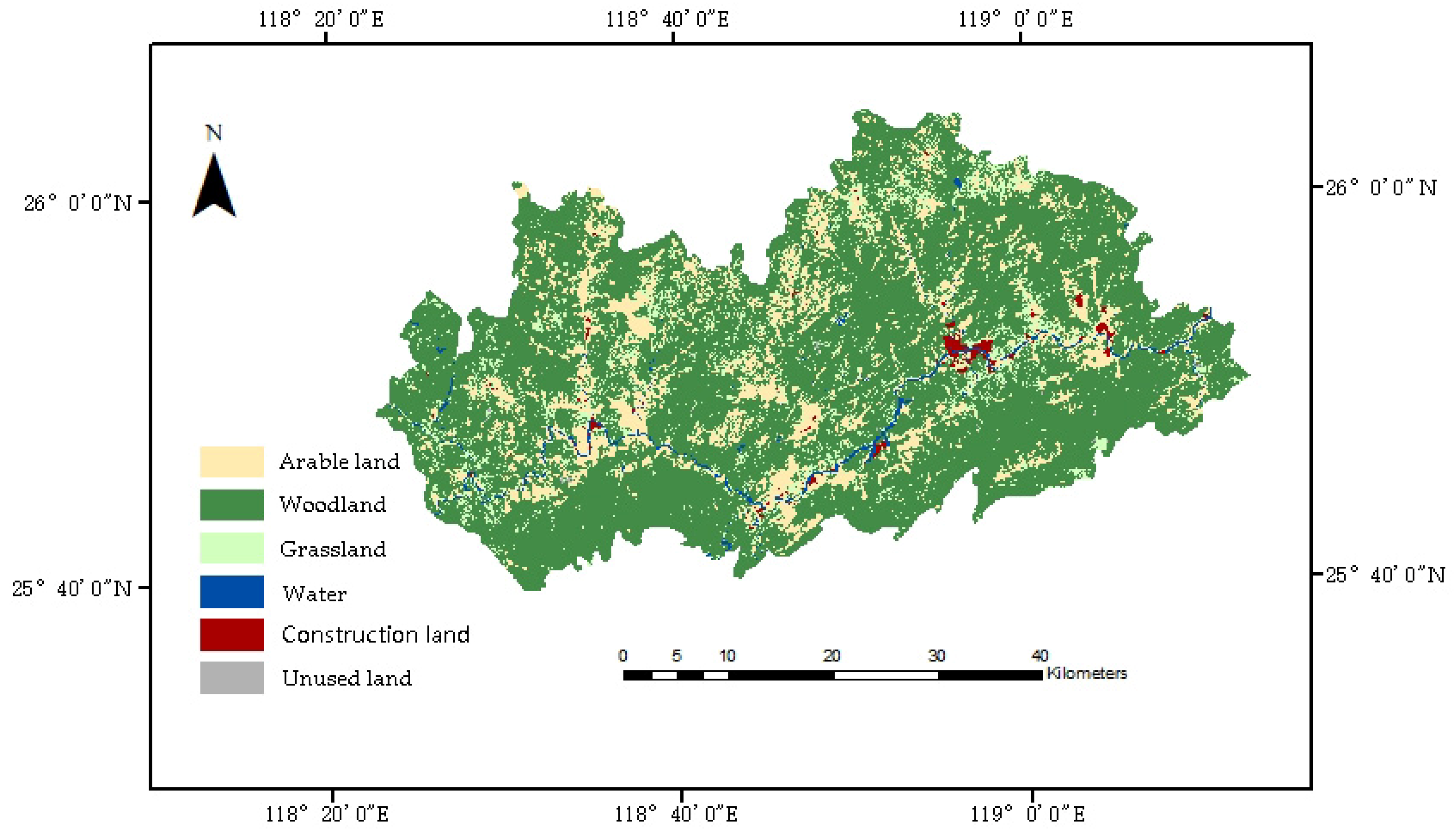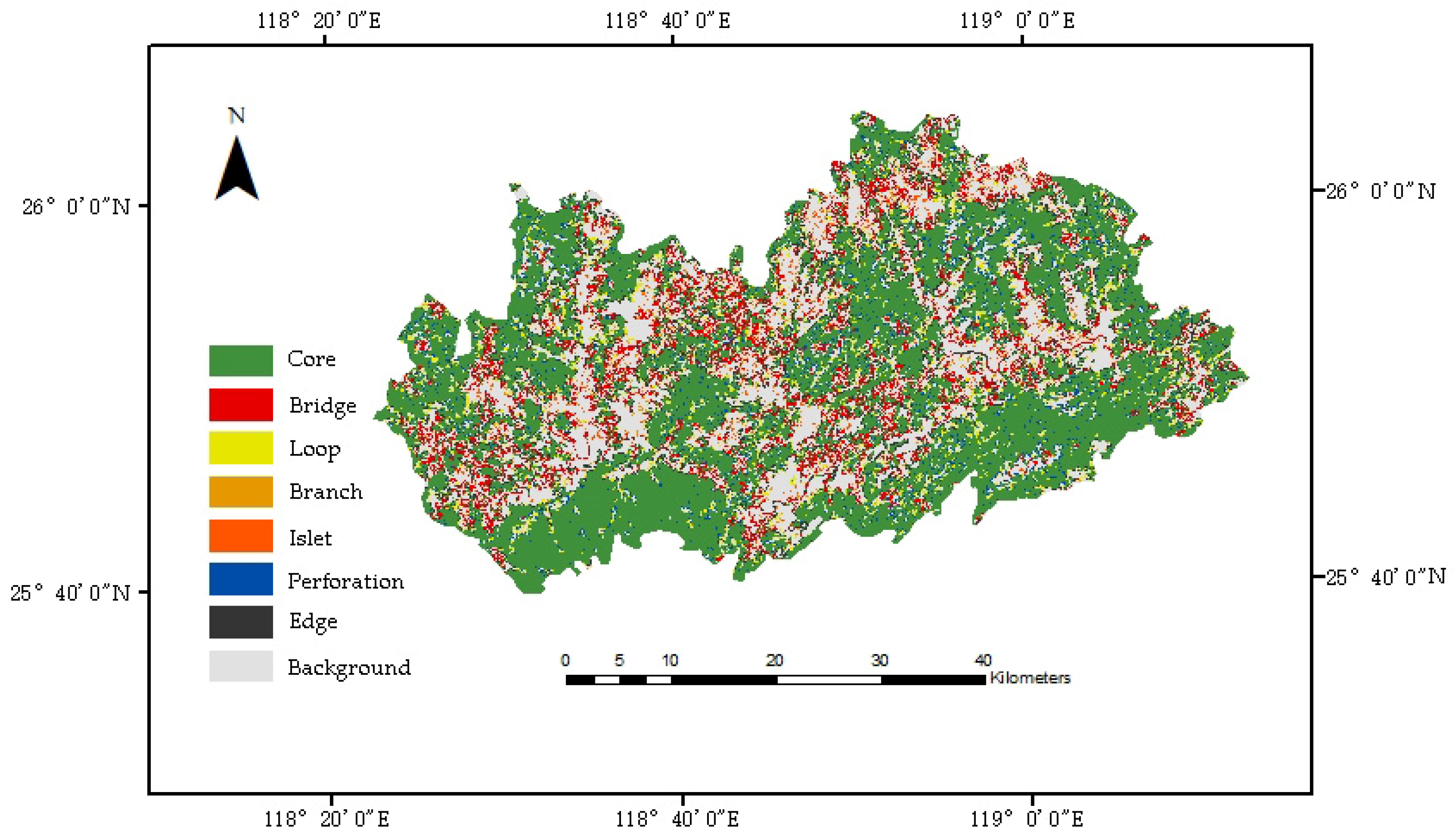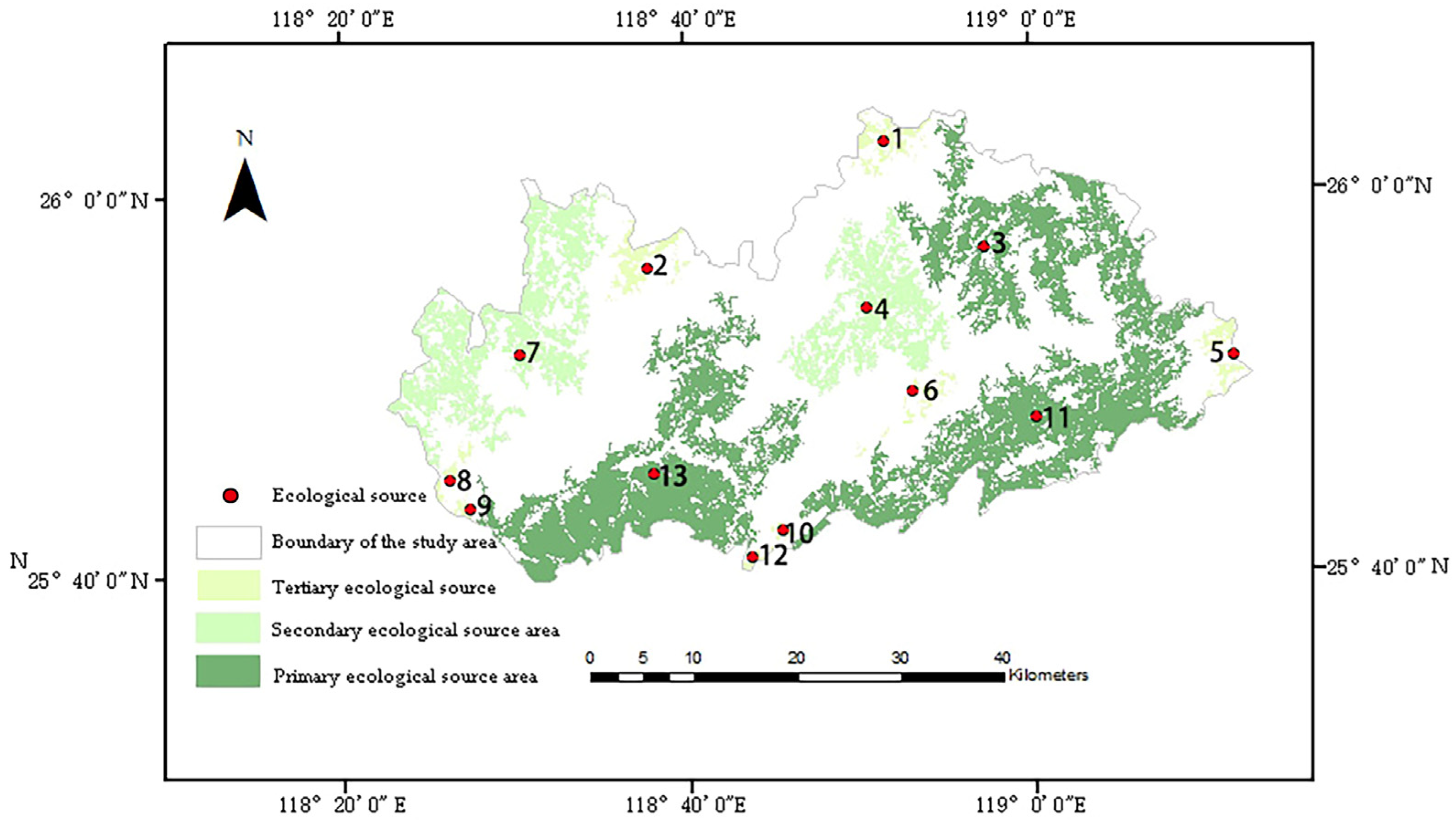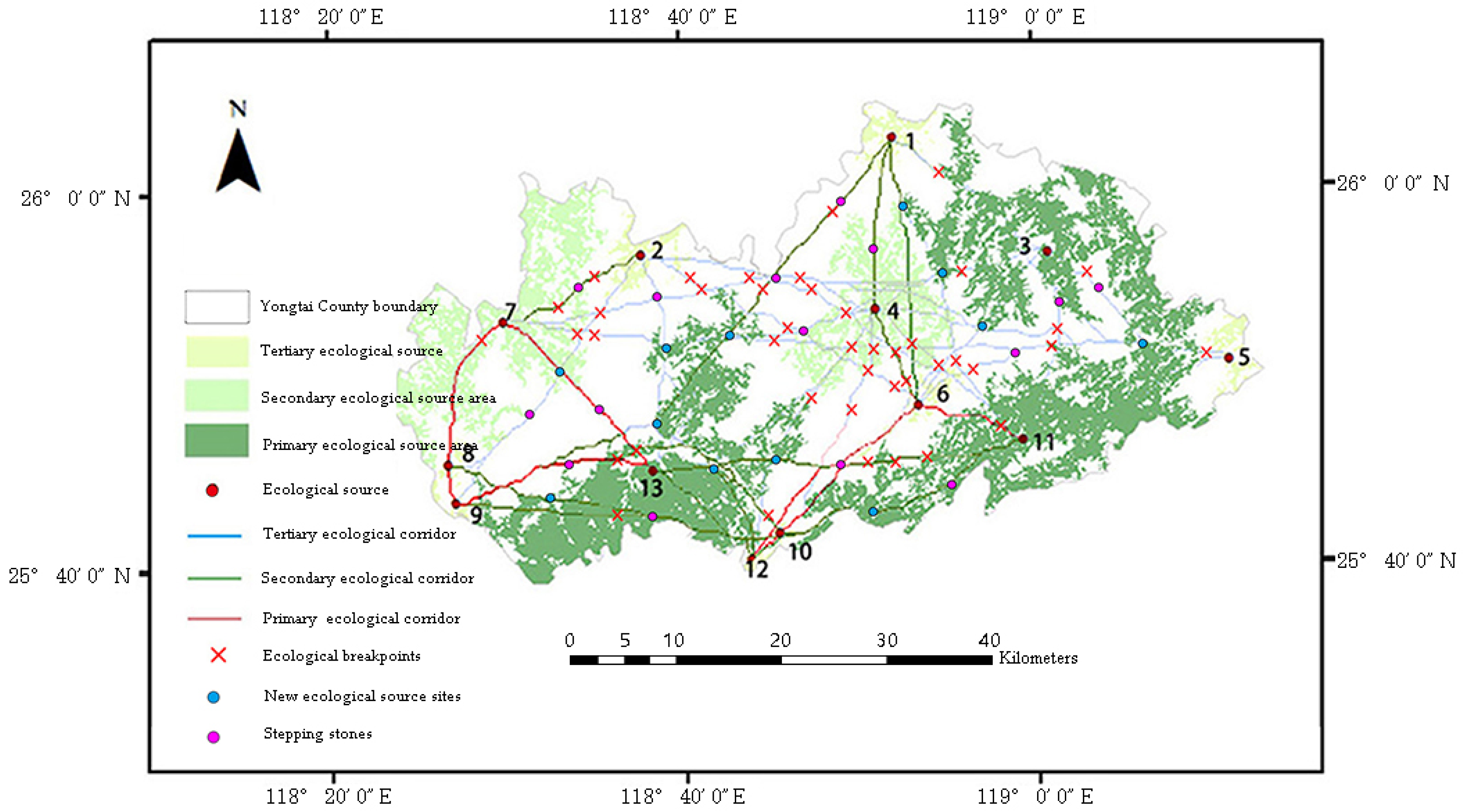Constructing Ecological Networks for Mountainous Urban Areas Based on Morphological Spatial Pattern Analysis and Minimum Cumulative Resistance Models: A Case Study of Yongtai County
Abstract
:1. Introduction
2. Materials and Methods
2.1. Study Area
2.2. Data Sources
2.3. Methods
2.3.1. Ecological Source Identification Based on MSPA
2.3.2. Ecological Source Site Selection for the Study Area Based on Landscape Connectivity
2.3.3. Ecological Network Construction Based on MCR Model
2.3.4. Gravity Model-Based Identification of Important Ecological Corridors
3. Results
3.1. Analysis of the Land Use Situation in Yongtai County
3.2. Landscape Pattern Analysis of Yongtai County Based on MSPA
3.3. Ecological Source Extraction and Landscape Connectivity Evaluation in Yongtai County
3.4. Ecological Network Construction and Analysis in Yongtai County
3.4.1. Extraction of Ecological Corridors in Yongtai County
3.4.2. Analysis of Ecological Corridors in Yongtai County
3.5. Optimization Strategy of Ecological Network in Yongtai County
3.5.1. Establish and Protect Ecological Sources
3.5.2. Rehabilitation of Ecological Breakpoints
3.5.3. Building Stepping Stones
4. Discussion
5. Conclusions
Author Contributions
Funding
Institutional Review Board Statement
Informed Consent Statement
Data Availability Statement
Conflicts of Interest
References
- Yuan, Y.H.; Xu, J.G. Research on the construction of landscape ecological network in mountainous cities. Urban Plan. 2015, 39, 105–112. [Google Scholar]
- Chen, Y.; Ma, Y.W.; Pan, J.F. Ecological network construction of a mountainous city taking into account the sensitivity of rocky desertification—A case study of Qujing City, Yunnan Province. J. Ecol. 2023, 43, 7060–7071. [Google Scholar]
- Chen, N.N.; Kang, S.Z. Construction of mountain ecological network in Qinling (Shaanxi section) based on MSPA and MCR models. J. Appl. Ecol. 2021, 32, 1545–1553. [Google Scholar]
- Zhang, S.F.; Li, Y.; Zhao, K.X. Optimization of green space landscape pattern in Guiyang City based on ecological network construction. China Gard. 2022, 38, 68–73. [Google Scholar]
- Du, Y.Y.; Hu, Y.N. Construction of ecological security pattern in southwest mountainous areas based on ecological importance and sensitivity—A case study of Dali Bai Autonomous Prefecture in Yunnan Province. J. Ecol. 2017, 37, 8241–8253. [Google Scholar]
- Li, H.; Liu, Y.; Li, Q.; Wang, X. Analysis of ecological security pattern in southern rare earth mining area based on MCR model. Geoscience 2020, 40, 989–998. [Google Scholar]
- Zhang, Y.X.; Biu, H.N. Construction of urban ecological security pattern based on MCR model—Taking Pingliang City in Gansu Province as an example. J. Nanjing Norm. Univ. (Nat. Sci. Ed.) 2021, 44, 54–62. [Google Scholar]
- Wang, X.L.; Wan, R.G. Construction and regulation of ecological security pattern in the Taihu Lake basin based on spatial morphology-minimum cumulative resistance model. J. Ecol. 2022, 42, 1968–1980. [Google Scholar]
- Qin, Z.B.; Xuan, J.; Huang, L.J. Construction of ecological network of island-type city based on MSPA and MCR modeling—Taking Pingtan Island of Fujian Province as an example. Soil Water Conserv. Res. 2023, 30, 303–311. [Google Scholar]
- Kowe, P.; Mutanga, O.; Dube, T. Advancements in the remote sensing of landscape pattern of urban green spaces and vegetation fragmentation. Int. J. Remote Sens. 2021, 42, 3797–3832. [Google Scholar] [CrossRef]
- Simpkins, C.E.; Dennis, T.E.; Etherington, T.R. Assessing the performance of common landscape connectivity metrics using a virtual ecologist approach. Ecol. Model. 2018, 367, 13–23. [Google Scholar] [CrossRef]
- Ke, S.; Zhang, Z.; Wang, Y. China’s forest carbon sinks and mitigation potential from carbon sequestration trading perspective. Ecol. Indic. 2023, 148, 110054. [Google Scholar] [CrossRef]
- Guo, H.Y.; Liu, J.W.; Chen, C.X. Construction of ecological network of nature reserves in Lancang River Basin of Yunnan Province. Soil Water Conserv. Bull. 2023, 43, 193–201. [Google Scholar]
- Clergeau, P.; Burel, F. The role of spatio-temporal patch connectivity at the landscape level: An example in a bird distribution. Landsc. Urban Plan. 1997, 38, 37–43. [Google Scholar] [CrossRef]
- Han, D.; Wang, C.; Yin, L.Q. Characteristics of nectar plant network and identification of important nectar plants in urban butterflies in Beijing. J. Ecol. 2021, 41, 8892–8905. [Google Scholar]
- Ostapowicz, K.; Vogt, P.; Riitters, K.H. Impact of scale on morphological spatial pattern of forest. Landsc. Ecol. 2008, 23, 1107–1117. [Google Scholar] [CrossRef]
- Rinaldo, A.; Gatto, M. River networks as ecological corridors: A coherent ecohydrological perspective. Adv. Water Resour. 2018, 112, 27–58. [Google Scholar] [CrossRef] [PubMed]
- Fábos, J.G. Green way plann in gin the United States: Its origins and recent case studies. Landsc. Urban Plan. 2004, 68, 321–334. [Google Scholar] [CrossRef]
- James, D.; Wickham, K.H.; Riitters, T.G. A national assessment of green infrastructure and change for the conterminous United States using morphological image processing. Landsc. Urban Plan. 2010, 94, 186–195. [Google Scholar]
- Koen, E.L.; Bowman, J.; Sadowski, C.; Walpole, A.A. Landscape connectivity for wildlife: Development and validation of multispecies linkage maps. Methods Ecol. Evol. 2014, 5, 626–633. [Google Scholar] [CrossRef]
- Jahanishakib, F.; Salmanmahiny, A.; Mirkarimi, S.H. Hydrological connectivity assessment of landscape ecological network to mitigate development impacts. J. Environ. Manag. 2021, 296, 113169. [Google Scholar] [CrossRef] [PubMed]
- Valero, E.; Álvarez, X.; Picos, J. Connectivity study in Northwest Spain: Barriers, impedances, and corridors. Sustainability 2019, 11, 5124. [Google Scholar] [CrossRef]
- Jongman, R.H. Ecological networks and greenways in Europe: Reasoning and concepts. J. Environ. Sci. 2003, 15, 173–181. [Google Scholar]
- Walker, N.J.; Schaffer-Smith, D.; Swenson, J.J. Improved connectivity analysis using multiple lowcost paths to evaluate habitat for the endangered San Martin titi monkey (Plecturocebus oenanthe) in north-central Peru. Landsc. Ecol. 2019, 34, 1859–1875. [Google Scholar] [CrossRef]
- Fremier, A.K.; Kiparsky, M.; Gmur, S.; Aycrigg, J.; Craig, R.K. A riparian conservation network for ecological resilience. Biol. Conserv. 2015, 191, 29–37. [Google Scholar] [CrossRef]
- Modica, G.; Praticò, S.; Laudari, L.; Ledda, A.; Di, F.S. Implementation of multispecies ecological networks at the regional scale: Analysis and multi-temporal assessment. J. Environ. Manag. 2021, 289, 112494. [Google Scholar] [CrossRef]
- Hashemi, R.; Darabi, H. The review of ecological network indicators in graph theory context: 2014–2021. Int. J. Environ. Res. 2022, 16, 24. [Google Scholar] [CrossRef]
- Pili, S.; Serra, P.; Salvati, L. Landscape and the city: Agro-forest systems, land fragmentation and the ecological network in Rome, Italy. Urban For. Urban Green. 2019, 41, 230–237. [Google Scholar] [CrossRef]
- Cunha, N.S.; Magalhaes, M.R. Methodology for mapping the national ecological network to mainland Portugal: Aplanning tool towards a green infrastructure. Ecol. Indic. 2019, 104, 802–818. [Google Scholar] [CrossRef]
- Harvey, E.; Gounand, I.; Ward, C.L.; Altermatt, F. Bridging ecology and conservation: From ecological networks to ecosystem function. J. Appl. Ecol. 2017, 54, 371–379. [Google Scholar] [CrossRef]
- Jing, H.; Chong, L.; Ying, Y.L. Construction of Greenland Ecological Network in West District of Zhuhai City Based on GIS. J. Northwest For. Coll. 2017, 32, 243–251. [Google Scholar]
- Chavez, J.P.S.; Berlin, G.L.; Sowers, L.B. Statistical method for selecting Landsat MSS ratios. J. Appl. Photogr. Eng. 1982, 8, 23–30. [Google Scholar]
- Hernandez, A.; Miranda, M.; Arellano, E.C. Landscape dynamics and their effect on the functional connectivity of a Mediterranean landscape in Chile. Ecol. Indic. 2015, 48, 198–206. [Google Scholar] [CrossRef]
- Bathiany, S.; Dakos, V.; Scheffer, M. Climate models predict increasing temperature variability in poor countries. Sci. Adv. 2018, 4, 5809. [Google Scholar] [CrossRef]
- Lumia, G.; Pratico, S.; Di, F.S. Combined use of urban Atlas and Corine land cover datasets for the implementation of an ecological network using graph theory within a multi-species approach. Ecol. Indic. 2023, 148, 110150. [Google Scholar] [CrossRef]
- Newton, A.C.; Hodder, K.; Cantarello, E. Cost–benefit analysis of ecological networks assessed through spatial analysis of ecosystem services. J. Appl. Ecol. 2012, 49, 571–580. [Google Scholar] [CrossRef]
- Víctor, R.; Javier, V.; Javier, G. Proposal of new Natura 2000 network boundaries in Spain based on the value of importance for biodiversity and connectivity analysis for its improvement. Ecol. Indic. 2021, 129, 461–468. [Google Scholar]
- Li, H.; Zheng, Y.T.; Huang, H. Construction of ecological network in Lushan City based on MSPA and MCR model. J. Cent. South For. Univ. Sci. Technol. 2024, 44, 98–107. [Google Scholar]
- Yang, W.Y.; Ye, H.Y. Identification of ecological networks in the Guangdong-Hong Kong-Macao Greater Bay Area based on habitat quality. J. Ecol. 2023, 43, 10430–10442. [Google Scholar]
- Liu, X.P.; Li, X.Y.; Li, Y.M. Construction and optimization of ecological networks in rapidly urbanizing areas—Taking Daxing District of Beijing as an example. J. Ecol. 2023, 43, 8321–8331. [Google Scholar]
- Du, X.Y.; Lu, F.N.; Wang, C.Y. Construction of county-scale ecological network based on MSPA-Conefor-MCR—Taking Yanqing District as an example. J. Appl. Ecol. 2023, 34, 1073–1082. [Google Scholar]
- Fang, Y.; Wang, J.; Huang, L.Y. Diagnosis and identification of key areas for ecological protection and restoration of national land space based on ecological security pattern—Taking Yantai City as an example. J. Nat. Resour. 2020, 35, 190–203. [Google Scholar]
- Gao, Y.; Mu, H.K.; Zhang, Y.L. Research on the optimization of the construction path of municipal scale green network system based on MSPA analysis method—Taking Zhaoyuan City as an example. J. Ecol. 2019, 39, 7547–7556. [Google Scholar]
- Hassan, S. Ecosystems and human well-being: Current state and trends. J. Bacteriol. 2005, 1, 1387–1404. [Google Scholar]
- Hawn, C.L.; Herrmann, J.D.; Griffin, S.R.; Haddad, N.M. Connectivity increases trophic subsidies in fragmented landscapes. Ecol. Lett. 2018, 21, 1620–1628. [Google Scholar] [CrossRef] [PubMed]
- Yang, K.; Cao, Y.G.; Feng, Z. Progress of ecological security pattern construction based on the least cumulative resistance model. J. Ecol. Rural Environ. 2021, 37, 555–565. [Google Scholar]
- Ye, H.; Yang, Z.; Xu, X. Ecological corridors analysis based on MSPA and MCR model—A case study of the Tomur World Natural Heritage Region. Sustainability 2020, 12, 959. [Google Scholar] [CrossRef]
- Zheng, Q.M.; Xing, Z.; Zhong, L.S. Construction of ecological security pattern in Pudacuo National Park. J. Ecol. 2021, 41, 874–885. [Google Scholar]
- Chen, X.; Peng, J.; Liu, Y.X. Construction of ecological security pattern in Yunfu City based on the framework of “importance-sensitivity-connectivity”. Geogr. Res. 2017, 36, 471–484. [Google Scholar]
- Lei, J.; Yan, X.Y. Evaluation of Urban Green Space System Planning Layout Based on Landscape Ecology—Taking Baotou Urban Area as an Example. J. Inn. Mong. Agric. Univ. (Nat. Sci. Ed.) 2007, 4, 248–253. [Google Scholar]
- Liu, Y.D.; He, Z.W.; Chen, J.H. Research on ecological network construction method based on MSPA and MCR modeling–Taking Nanchong City as an example. Southwest J. Agric. 2021, 34, 354–363. [Google Scholar]
- Han, S.H.; Mei, Y.G.; Ye, Z.Y. Construction of ecological security pattern in Yanping District, Nanping City, Fujian Province based on the least cumulative resistance model. Soil Water Conserv. Bull. 2019, 39, 192–198+205. [Google Scholar]
- Jiang, S.M.; Zhang, Y.; Tao, H.C. Construction and evaluation of green space ecological network in Guangzhou. J. Sun Yat-Sen Univ. (Nat. Sci. Ed.) 2016, 55, 162–170. [Google Scholar]
- Johnston, S.; Good, R. The Benefits of Restored Linear Vegetation Corridors for Biodiversity Conservation: A Case Study. Australas. Plant Conserv. J. Aust. Netw. Plant Conserv. 2016, 24, 22–24. [Google Scholar] [CrossRef]
- Chen, X.Y.; Chen, W.B. Construction and evaluation of ecological network in Poyang Lake Ecological and Economic Zone. J. Appl. Ecol. 2016, 27, 1611–1618. [Google Scholar]
- Loro, M.; Ortega, E.; Arce, R.M.; Geneletti, D. Ecological connectivity analysis to reduce the barrier effect of roads. An innovative graph⁃theory approach to define wildlife corridors with multiple paths and without bottlenecks. Landsc. Urban Plan. 2015, 139, 149–162. [Google Scholar] [CrossRef]
- Csermely, P. The wisdom of networks: General adaptation and learning mechanism of complex systems: The network core triggers fast responses to Known Stimulis innovations require the slow network periphery and are encoded by core-remodeling. Bioessays 2017, 40, 1700150. [Google Scholar] [CrossRef]







| Landscape Types | Description |
|---|---|
| Core | High vegetation coverage, with ecological functions such as providing habitats for biological species, is of great significance for biodiversity conservation, and covers large habitat patches. |
| Bridge | Long narrow patches connecting more than two core areas play a role in corridor connectivity for species migration and energy exchange. In this study, this is manifested as strip green spaces, protective forest belts, and river channels with riverbank green belts. |
| Islet | Relatively isolated, habitat patches can serve as stepping stones for biological migration. |
| Branch | Only one end is connected to the core area, which is conducive to the local diffusion of core area biota patches. |
| Loop | Pathway for the exchange of material energy within the same core area. |
| Perforation | Small non-habitat patches within large habitat patches. |
| Edge | Transition zones with obvious edge effects between core areas and non-habitat patches, serve as buffer zones between core areas and external backgrounds or non-habitat patches. |
| Resistance Factor | Classification | Resistance Value | Weight |
|---|---|---|---|
| MSPA Landscape Type | Core, Bridge | 1 | 0.2 |
| Branch, Islet | 2 | ||
| Loop, Edge | 3 | ||
| Perforation | 4 | ||
| Background | 5 | ||
| Distance from road (m) | <120 | 1 | 0.25 |
| 120~200 | 2 | ||
| 200~300 | 3 | ||
| 300~400 | 4 | ||
| >400 | 5 | ||
| Elevation (h)/m | <275 | 1 | 0.15 |
| 275~500 | 2 | ||
| 500~700 | 3 | ||
| 700~960 | 4 | ||
| >960 | 5 | ||
| Land Use | Wetland | 1 | 0.25 |
| Woodland | 2 | ||
| Arable land Grassland | 3 | ||
| Naked land | 4 | ||
| Construction Land | 5 | ||
| Slope (i) | <10 | 1 | 0.20 |
| 10~25 | 2 | ||
| 25~35 | 3 | ||
| 35~45 | 4 | ||
| >45 | 5 |
| Type | Area/km2 | Percentage of Foreground Area/% | Percentage of Study Area/% |
|---|---|---|---|
| Core | 1071.06 | 64.52% | 48.02% |
| Bridge | 206.82 | 12.46% | 9.27% |
| Islet | 13.99 | 0.84% | 0.63% |
| Edge | 154.26 | 9.29% | 6.92% |
| Perforation | 78.15 | 4.71% | 3.50% |
| Loop | 94.84 | 5.71% | 4.25% |
| Branch | 40.99 | 2.47% | 1.84% |
| Total | 1660.12 | 100.00% | 74.42% |
| Code | dPC | Area (km2) | Area as a Percentage of Total Ecological Source Area (%) |
|---|---|---|---|
| 13 | 61.75 | 236.95 | 25.15% |
| 11 | 41.68 | 206.35 | 21.90% |
| 3 | 35.67 | 168.79 | 17.92% |
| 7 | 27.18 | 147.76 | 15.69% |
| 4 | 17.29 | 92.62 | 9.83% |
| 10 | 7.89 | 2.99 | 0.32% |
| 12 | 6.95 | 3.14 | 0.33% |
| 8 | 5.53 | 7.23 | 0.77% |
| 9 | 4.99 | 3.28 | 0.35% |
| 1 | 4.28 | 21.16 | 2.25% |
| 2 | 3.78 | 22.19 | 2.36% |
| 6 | 3.07 | 14.49 | 1.54% |
| 5 | 2.75 | 15.07 | 1.60% |
| Code | 1 | 2 | 3 | 4 | 5 | 6 | 7 | 8 | 9 | 10 | 11 | 12 | 13 |
|---|---|---|---|---|---|---|---|---|---|---|---|---|---|
| 1 | 0 | 3.89 | 6.03 | 10.13 | 3.34 | 195.75 | 54.95 | 26.30 | 42.19 | 31.70 | 41.75 | 34.94 | 29.06 |
| 2 | 0 | 0.39 | 1.51 | 0.50 | 32.92 | 156.76 | 31.11 | 49.31 | 16.02 | 6.13 | 17.96 | 35.56 | |
| 3 | 0 | 1.64 | 1.80 | 54.88 | 6.85 | 4.21 | 6.75 | 6.85 | 16.45 | 7.38 | 5.42 | ||
| 4 | 0 | 1.22 | 242.87 | 19.40 | 9.49 | 15.35 | 18.14 | 22.27 | 18.63 | 14.56 | |||
| 5 | 0 | 56.91 | 11.26 | 6.98 | 11.16 | 9.41 | 28.51 | 10.42 | 8.11 | ||||
| 6 | 0 | 697.94 | 416.11 | 676.21 | 1518.93 | 2040.47 | 1413.03 | 793.56 | |||||
| 7 | 0 | 3456.10 | 3409.66 | 484.46 | 141.01 | 541.15 | 1267.32 | ||||||
| 8 | 0 | 50,793.22 | 279.48 | 85.94 | 313.56 | 862.52 | |||||||
| 9 | 0 | 460.18 | 138.40 | 516.06 | 1466.75 | ||||||||
| 10 | 0 | 166.86 | 13,350.39 | 926.64 | |||||||||
| 11 | 0 | 174.81 | 121.45 | ||||||||||
| 12 | 0 | 950.50 | |||||||||||
| 13 | 0 |
Disclaimer/Publisher’s Note: The statements, opinions and data contained in all publications are solely those of the individual author(s) and contributor(s) and not of MDPI and/or the editor(s). MDPI and/or the editor(s) disclaim responsibility for any injury to people or property resulting from any ideas, methods, instructions or products referred to in the content. |
© 2024 by the authors. Licensee MDPI, Basel, Switzerland. This article is an open access article distributed under the terms and conditions of the Creative Commons Attribution (CC BY) license (https://creativecommons.org/licenses/by/4.0/).
Share and Cite
Zou, C.; Tang, X.; Tan, Q.; Feng, H.; Guo, H.; Mei, J. Constructing Ecological Networks for Mountainous Urban Areas Based on Morphological Spatial Pattern Analysis and Minimum Cumulative Resistance Models: A Case Study of Yongtai County. Sustainability 2024, 16, 5559. https://doi.org/10.3390/su16135559
Zou C, Tang X, Tan Q, Feng H, Guo H, Mei J. Constructing Ecological Networks for Mountainous Urban Areas Based on Morphological Spatial Pattern Analysis and Minimum Cumulative Resistance Models: A Case Study of Yongtai County. Sustainability. 2024; 16(13):5559. https://doi.org/10.3390/su16135559
Chicago/Turabian StyleZou, Cheng, Xiaoxiang Tang, Qian Tan, Huicheng Feng, Huanyu Guo, and Junxiang Mei. 2024. "Constructing Ecological Networks for Mountainous Urban Areas Based on Morphological Spatial Pattern Analysis and Minimum Cumulative Resistance Models: A Case Study of Yongtai County" Sustainability 16, no. 13: 5559. https://doi.org/10.3390/su16135559






